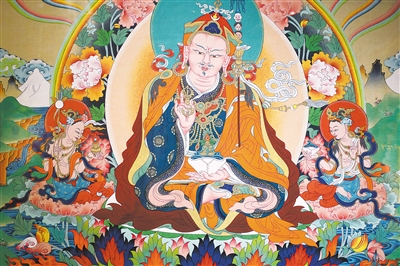
 |
| A thangka painting on display in Chifeng, north China's Inner Mongolia autonomous region. (PHOTO: VCG) |
Regong arts, primarily recognized for their thangka paintings, are a significant and unique aspect of Tibetan Buddhist culture. In 2009, they were added to UNESCO's Representative List of the Intangible Cultural Heritage of Humanity.
Regong translates to "golden valley where dreams come true" in Tibetan language. This "valley" is situated in the middle reaches of the Longwu River in Tongren, Qinghai province. In the 13th century, Regong arts emerged from this "valley" and evolved into a well-known tradition of Tibetan Buddhist art. As a collection of diverse artistic forms, Regong arts mainly include thangka painting, sculpture, embroidery, and architectural embellishment. Monks, folk artists, as well as local farmers, herdsmen, and craftsmen from diverse ethnic groups have played a role in nurturing this cultural heritage.
As one of the most widely recognized forms of Regong arts, thangka paintings have gained fame around the world. Renowned for their intricate craftsmanship, vibrant colours, and deep symbolism, thangkas are primarily made to honor the Buddha, legendary deities, and distinguished monks. These artworks vary greatly in size, with the large pieces regarded as extremely valuable and sought after by temples, museums, and collectors.
Another distinct feature of thangka paintings is their exquisite colours, predominantly sourced from natural minerals that can protect the vibrancy of artworks from fading for several centuries. Regong artists grind various minerals and metals including gold, silver, turquoise, malachite, saffron, and indigo to produce vibrant pigments. Additionally, the artists rigorously adhere to the Lection of Measurement, a Buddhist art book, to create lines, form shapes, select colors, design patterns, and produce decorative effects.
"The important historical cultural heritage reflects the essence of the culture of Tibetan Buddhism monasteries and folk arts in Regong areas, having remarkable social, historical and artistic values," according to UNESCO.







